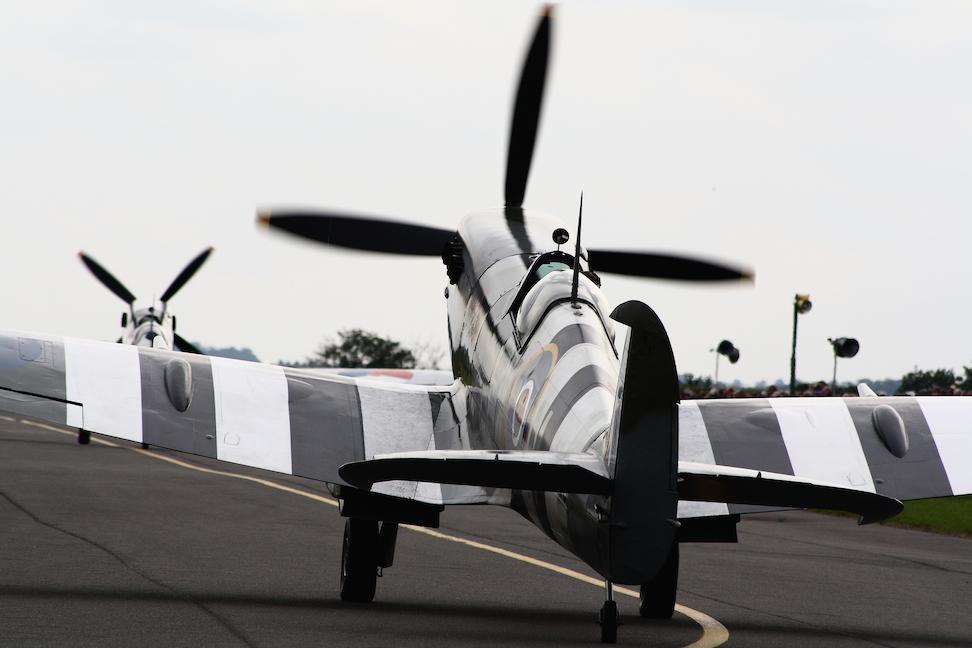In 1940, the British were desperate for combat aircraft and were willing to consider just about anything that had wings, irrespective of how poor its performance might be. Consequently, when Bell submitted specifications to the British Direct Purchase Commission for a fighter with a top speed of 400 mph, a ceiling of 36,000 feet, and a range of 1000 miles, the Commission literally salivated on the spot and ordered 675 Bell Model 14s sight unseen on April 13, 1940.
Unfortunately, Bell's glossy advertising brochures did not distinguish between the performance of a lightly-loaded, unarmed, highly-polished experimental prototype and a production fighter heavily-loaded with military equipment and armament, and the British were to rue the day that they ever looked at an Airacobra.
The first of these P-39Cs actually arrived at RAF Colerne on July 3, 1941, followed by the other two the next day. It made its first test flight in England on July 6. However, during trials at Duxford, the performance proved disappointing. Although the test pilots praised the general ease of handling of the aircraft, the maximum speed was a shocking 33 mph lower than that anticipated. The fighter proved to be definitely inferior to the Hurricane and Spitfire in climb rate and ceiling, and the 750-yard takeoff run of the Airacobra excluded its operation from some smaller fighter airfields. There was universal shock and dismay among the RAF personnel. What had gone wrong? Bell Aircraft executives later sheepishly admitted that their performance figures had been based on the unarmed and unequipped XP-39 prototype, which weighed a ton less than the armed and equipped P-39C.
No. 601 Squadron pilots found numerous flaws and weaknesses during their initial work-up with the the Airacobra. Numerous modifications were made in the field in an attempt to make the aircraft suitable for combat. A master valve was introduced to allow oxygen to be turned on from the cockpit. The gunsight was modified to improve forward visibility. Changes to the ammunition tanks for the wing guns were made. Modifications were made to the cockpit harness release in order to simplify the operation. The IFF (Identification, Friend or Foe) set was removed from behind the pilot, where it obstructed aft view. A throttle control quadrant friction damper was introduced.
The AFDU also did some comparative dog-fighting tests with the Airacobra against a Spitfire VB and a captured Messerschmitt BF 109E. The Airacobra and the Bf 109E carried out mock dog-fighting at 6000 feet and 15,000 feet. The Bf 109E had a height advantage of 1000 feet in each case. The Bf 109, using the normal German fighter tactics of diving and zooming, could usually only get in a fleeting shot. The Bf 109 could not compete with the Airacobra in a turn, and if the Bf 109 were behind the Airacobra at the start, the latter could usually shake him off and get in a burst before two complete turns were completed. If the Bf 109 were to dive on the Airacobra from above and continue the dive down to ground level after a short burst of fire, it was found that the Airacobra could follow and catch up to the Bf 109 after a dive of over 4000 feet. When fighting the Bf 109E below 20,000 feet, the Airacobra was superior on the same level and in a dive.
A similar trial was carried out against a Spitfire V. Although the Airacobra was faster than the Spitfire up to 15,000 feet, it was outclimbed and out-turned by the Spitfire. Unless it had a height advantage, the Airacobra could not compete with the Spitfire.
The Airacobra was considered to be very suitable for low altitude operations because of the excellent view and controllability, and it was fully maneuverable at speeds above 160 mph. It was not difficult to fly at night, but the exhaust flames could be seen by another aircraft flying three miles to the rear. The flash from the nose guns was blinding, and could cause the pilot to lose not only his target but also his night vision. Firing of the nose guns caused the buildup of carbon monoxide contamination in the cockpit, and this could reach a lethal level very quickly. The guns were fairly inaccessible, and maintenance was troublesome. In December of 1941, the Airacobra was officially withdrawn from operational service with the RAF.
Length: 30' 2"
Wingspan: 34' 0"
Gross Weight: 7180.00 lbs
Powerplant: Allison V-1710-35 Horsepower 1150
Max Speed: 379.00 Mph







